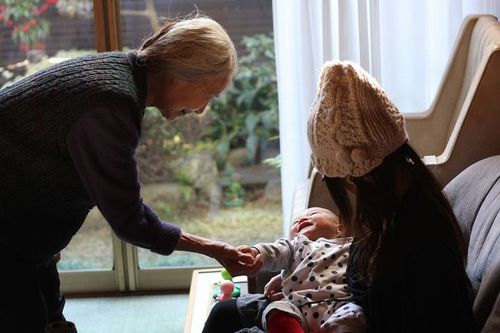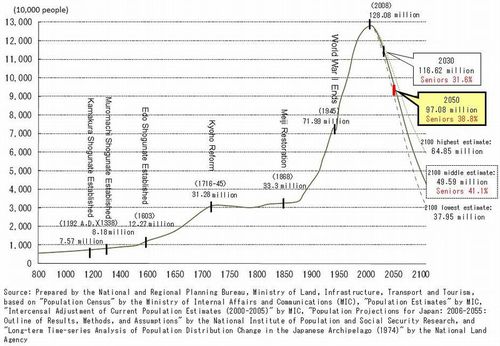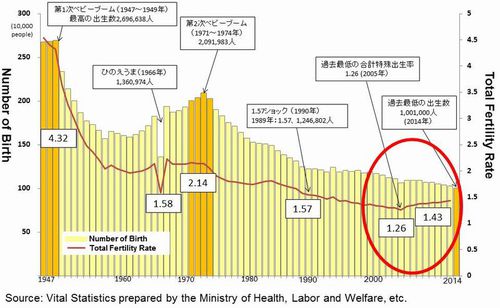July 13, 2015
Japan's Depopulating Society: Population Concentration in Tokyo and the Disappearance of Local Municipalities (Part 1)
Keywords: Aging Society Newsletter Population Decline Steady-State Economy
JFS Newsletter No.154 (June 2015)

Image by Toshimasa Ishibashi Some Rights Reserved.
A report released in May 2014, the so-called "Masuda Report," made a big impact throughout Japan with its prediction that almost half of municipalities in the nation might disappear due to population decline and an inability to maintain administrative functions. Since these "municipalities at risk of vanishing" are mostly located in rural areas, people have rapidly become aware of the urgent need to cope with rural community issues.
The term "municipalities at risk of vanishing" ("shometsu kanosei toshi" in Japanese) was coined by the Japan Policy Council (JPC), a private think tank headed by Hiroya Masuda, a guest professor at the Graduate School of Public Policy of the University of Tokyo. On April 23, 2015, he gave a lecture on this topic at the invitation of the Institute for Studies in Happiness, Economy and Society, an organization that JFS is working with as an outreach partner.
From his talk, we learned that depopulation is not just an issue for rural areas, but also one to be tackled by the whole nation. In addition, we realized that Tokyo might face more difficulties than rural areas. The JFS Newsletter introduces here an excerpt from his speech, focusing on the big picture of the issue in Japan (Part 1) and the relationship between Tokyo and rural areas (Part 2) in a future newsletter.
Lecture by Hiroya Masuda
Rural Depopulation I Witnessed as Governor
I served as governor of Iwate Prefecture in northern Japan for 12 years, from 1995 to 2007. During that period, I actually witnessed the shrinking of populations in rural areas. For example, in the early days of my governorship, I saw many young adults at coming-of-age ceremonies, held by small municipalities, which I attended as a guest. However, near the end of my term, the number of young people at the ceremonies had dropped significantly. In some cases, the number of young people was just a little more than a dozen, including those who came home from Tokyo to attend. That was less than the number of guests. So I could see that the number of 20-year-olds still living in their home towns was really small.
The number of elementary schools also decreased to a surprising degree. Seeing a drop in the number of young people at coming-of-age ceremonies and in the number of elementary schools, I wondered how it could have happened. As governor, I wanted some data on shrinking populations, by municipality. How much of their populations were municipalities losing and how quickly?
No data on future populations at the municipal level were available, however, because of the difficulty in estimating demographic changes caused by social factors, such as young people leaving home for higher education or getting a job in another area. It was only in 2003 that the National Institute of Population and Social Security Research (IPSS) released the first projections of municipal-level populations. Since then, the IPSS has produced demographic projections by municipality every five years, with the latest data released in 2013. Based on the 2013 data, the Japan Policy Council, to which I belong, made its own estimation.
Note that there is a difference in the projections between the IPSS and JPC. We estimated that the process of increasing concentration of population in Tokyo would continue longer than the IPSS thought. We predicted that the population of Tokyo would gradually increase until the 2020 Tokyo Olympics. Thus, according to our overall estimation, the population of Tokyo would not decrease very much, while local municipalities would continue losing their populations.
The JPC summarized the result of its estimation on municipalities at risk of vanishing. It shows that the population of women aged from 20 to 39 is estimated to decline to less than half during the period from 2010 to 2040 in 869 municipalities (49.8 percent of all the municipalities in Japan).
Japan's Historical Population Trends Now and into the Future
The Japanese population increased slowly from 7.57 million in the Kamakura era (A.D. 1185 - 1333) to 30 million by the end of the Edo era (1603 - 1867), with the populations of the period greatly affected by rice yields. In the Meiji period (1868 - 1912) the population dramatically increased, reaching 100 million in only about 100 years. (The Japanese population passed the 100 million mark in 1967.)
Now the population is dropping at the same pace as it grew, after peaking at 128.08 million in 2008. According to medium-range projection, the Japanese population will be less than 50 million in 2100, 85 years from now.

(Click the graph for larger image)
In short, the Japanese population gradually grew from the beginning of the Meiji period, increased by 70 million in the 140 years up to 2008, and is about to decrease by 70 million in the 90 years leading up to the year 2100.
It is quite tough to stop this significant decrease. Normally the number of births increase if the birth rate increases, but in Japan today, the number of births is not increasing even if the birth rate rises.
In Japan, the total fertility rate today (the number of children that would be born to a woman aged 15 to 49) is on a recovering trend. After the post-war baby boom, the rate declined steadily, except in the second baby boom (the generation of post-war baby boomers' children), and reached 1.26 in 2005. It increased to 1.43 in 2013, and although the birth rate has increased compared to 10 years ago, the number of births has been constantly declining.
Why has the number of births not increased even as the birth rate has been increasing? It is because the number of young people who can bear children has been dropping. The population age distribution shows that the last second-baby-boomer was born in 1974, which means those in that group are over 40 years old now. So, the number of young people will dramatically decrease in the future, as 95 percent of women who may give birth to children are in the 20- to 39-year-old age bracket. This means that, even if the birth rate were to increase slightly, the number of births will never increase. The relation of the birth rate and the number of births represents a major feature of Japan today.

(Click the graph for larger image)
Even if were able to carry out every possible countermeasure from now on, the number of births will still decrease to about 700,000 per year, of which approximately half are girls. So we have to devise ways to increase the number of babies born to those 350,000 women. I think it necessary for that purpose to consider a social mechanism with a focus on the ways young people live in society.
What Can Be Done to Reduce How Population Declines?
The Japanese government set a target to keep the population above 100 million until 2060 and stabilize it at around 90 million in and after 2100. I think this will be difficult to attain.
To attain its target, the government aims to increase the birthrate to 2.07 (in replacement level) by 2040. Even in France, however, which is the most advanced country renowned for its high birthrate, the rate is 2.01. You can easily imagine how difficult it would be to increase the birthrate in Japan to a higher level than France's. In addition, even if Japan's birthrate increased to 2.07, the population will still decrease by 40 million by 2100 compared to now.
An important measure to counter such a situation is to change the ways we work in Japan, by raising the minimum wage, shortening working hours, and increasing the number of hours for enjoying things other than work.
Japanese working women are frequently confronted with the choice between work and family, which leads to low fertility. In contrast, in Sweden, the higher social participation of women has led to higher fertility. Some economists estimate that, if the ways of working are changed so as to boost the birthrate of working women, the effect would be equivalent to adding 10 million workers, which would make up for the portion lost by the shrinking of the population.
Another problem is long working hours. The average number of hours worked per worker per annum is 1,728 hours in Japan, 1,476 hours in France, and 1,644 hours in Sweden. Workers who work 49 hours or more a week are 22.7 percent of workers in Japan, 11.6 percent in France, and 7.6 percent in Sweden. The average hours spent doing housework and childcare by a husband is one hour a day in Japan, two hours and a half in France, and three hours and 20 minutes in Sweden. These data show the difficulties in raising children in Japan.
Another feature of Japan is the extremely low proportion of children born outside of marriage. Many other countries have changed their legal systems to allow common-law marriage, with the hope of putting a stop to declining populations. The proportion of children born outside of marriage is 2.1 percent in Japan, 52.6 percent in France, and 43.7 percent in England. How we define the family is a matter of debate, but it may have a major impact on population.
To be continued in Part Two
Edited by Junko Edahiro and Naoko Niitsu.
Related
"JFS Newsletter"
- 'Good Companies in Japan' (Article No.4): 'Eightfold Satisfaction' Management for Everyone's Happiness
- "Nai-Mono-Wa-Nai": Ama Town's Concept of Sufficiency and Message to the World
- 'Yumekaze' Wind Turbine Project Connects Metro Consumers and Regional Producers: Seikatsu Club Consumers' Co-operative
- Shaping Japan's Energy toward 2050 Participating in the Round Table for Studying Energy Situations
- 'Good Companies in Japan' (Article No.3): Seeking Ways to Develop Societal Contribution along with Core Businesses


